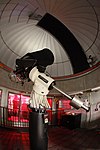Nativity of Our Lord Catholic School
Nativity of Our Lord Catholic School is located in Saint Paul, Minnesota, United States. It is a private and Catholic PreK-8 grade school. The school was founded in 1928 and has expanded over the years, the most recent time being in 2008. A large renovation, including the new library and new entrance way were added that year. In December 2017 and January 2018, the school's gymnasium got a new floor after the old floor began lifting during a November renovation. It was also re-painted. Nativity of Our Lord School is a community of parents, teachers, staff, and parishioners committed to helping each student grow into the person God has called them to be through faith, academics, and character development.
Excerpt from the Wikipedia article Nativity of Our Lord Catholic School (License: CC BY-SA 3.0, Authors).Nativity of Our Lord Catholic School
West Stanford Avenue, Saint Paul Macalester - Groveland
Geographical coordinates (GPS) Address Website Nearby Places Show on map
Geographical coordinates (GPS)
| Latitude | Longitude |
|---|---|
| N 44.931944444444 ° | E -93.180833333333 ° |
Address
Nativity of Our Lord Catholic School
West Stanford Avenue
55105 Saint Paul, Macalester - Groveland
Minnesota, United States
Open on Google Maps







